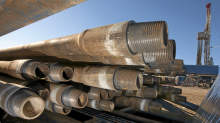China moving up Canada's energy value chain
 The billions of dollars Asian energy firms have invested in Canada in recent years have flowed almost exclusively into oil and gas fields, the raw reserves of the energy patch.
The billions of dollars Asian energy firms have invested in Canada in recent years have flowed almost exclusively into oil and gas fields, the raw reserves of the energy patch. Now, the second act is beginning. On an eight-acre property in Nisku, Alberta’s manufacturing heartland, a Hong Kong-based company is building a new plant. When it’s running later this year, the Hilong Holding Ltd. plant, its first in North America, will coat the inside of drilling pipes with anti-corrosion material.
As Canada and Asia deepen their energy ties, the trading relationship is beginning to expand beyond Chinese companies buying Canadian oil. Instead, foreign investment interest is starting to move across the sector’s value chain.
Signs of a widespread move are growing: PetroChina Co. Ltd. has expressed interest in building Enbridge Inc.’s Northern Gateway pipeline. A Chinese company proposed to provide finance, design and build an Alberta first nations oil refinery. Chinese services firms have mounted an increasingly significant presence at regular Canada-China energy forums run by University of Alberta political science professor Wenran Jiang, who has served as an important liaison between the two countries.
“There are companies who are actively trying to set up their own branch office in Calgary,” Prof. Jiang said. Chinese investments are being readied in numerous sectors, including Canadian electrical power and agriculture, he said.
But from an Asian perspective, the huge investments in oil and gas resources – both in oil sands and unconventional gas – have only served to highlight the abundance of energy Canada contains. That, in turn, has made clear the opportunity in related businesses, and is part of what drew Hilong to Alberta.
“Canada has the second-largest oil reserves in the world, so Canada will be among the last countries to have oil,” said Tony Wang, Hilong’s chief representative in Canada. “So why not? It’s for the long run.”
Besides, Canada is beginning to appear more attractive relative to other Asian energy adventures. In Libya, for example, Chinese companies had signed some $18-billion in contracts before Moammar Gadhafi’s regime was overthrown. Now, heavy losses are expected on those deals.
Canada, by contrast, is “very stable. It’s very lawful. It’s not like Russia, where the policy changes quite often,” Mr. Wang said.
Hilong is currently installing equipment in its plant, which will apply coatings to pipe imported from China. The company plans to launch operations before winter, and expects to begin with a staff of roughly 20, hired locally.
Chinese firms, of course, have long sold manufactured goods to the Alberta oil patch. Roughly 30 to 40 per cent of some products sold by drilling fluid distributor Canamara United Supply, for example, are made in China, and the numbers are rising.
But direct investments in Canada are an extension of this business. They are driven in part by Canada’s leadership in technological changes sweeping energy production. That has stirred promise for companies like Greatwall Drilling Co., a subsidiary of China National Petroleum Corp. that first came to Canada in 1997. It operates five drilling rigs, which are working near Estevan, Sask., but is nurturing expansion plans.
“We want to develop other services – for example, fracturing and horizontal drilling,” said Baoliang Chen, president of GWDC Alberta Oilfield Service Ltd., the company’s Canadian operating name. Greatwall hopes to invest by joint venture, then take what it learns here to help tap difficult-to-reach reserves in China and elsewhere.
The spectre of growing Chinese investments, especially those aimed at technology transfer, is galling to some. But others see it as important to expanding trade with a partner that stands to become more important as the United States lessens its dependence on energy imports.
“We can’t just close our doors to them and expect them to buy our products when we get it onto ships,” said Mark Salked, president of the Petroleum Services Association of Canada. Mr. Salked has received several inquiries from Asian companies interested in assessing the Canadian business landscape, and joining his association.
“I am seeing signs of a beginning of a trend,” he said. “The door is opening across the whole gamut of the oil and gas services sector.”
You can return to the main Market News page, or press the Back button on your browser.

